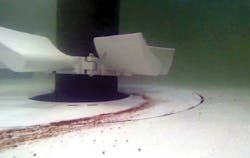Forced Vortex Baffle Developments Improve Grit Removal Performance and Design Flexibility
In today’s domestic wastewater treatment plant landscape, forced vortex chamber systems are the predominate choice for grit removal. These systems capably protect downstream processes and equipment from abrasion or poor performance from reduced capacity. Forced hydraulic vortex systems, such as the Smith & Loveless Pista grit removal system, are most commonly specified not only for grit removal efficiencies, but also the decades of system development over time, including improvements in baffle technology that offer performance and design flexibility benefits.
Forced hydraulic systems are not settling devices, like virtually all other grit systems. Instead, these chamber designs optimize flow paths and velocities to generate a true forced hydraulic vortex path that effectively removes grit. To accomplish this hydraulic action, the systems combine a specifically inclined inlet flume, a circular chamber with a flat-floor upper chamber and lower collection hopper, an effluent trough and, depending on the design flows, patented integral baffle arrangements.
Recent Smith & Loveless developments in forced vortex chamber technology provide for fine grit removal and the industry standard 95% removal efficiency for grit particles sized down to 105 microns (140 mesh). The driving force, literally, is the integral V-Force baffle, which ensures the proper velocity and extended flow path around the entire 360 degrees to sweep the entering grit along the chamber flat floor and into a center core opening to the lower collection hopper. The nearby center rotating paddles above the opening serve to lift and separate lighter organic material in the center (enabling it to continue downstream) while the heavier grit particles retreat to the lower hopper. No additional downstream control devices are required to keep the velocity in the preferred range during both peak flow and minimum flow, as the system possesses a 10-to-1 turndown.
Smith & Loveless has introduced two new integrated baffle and forced vortex technologies that address varied but other needs for wastewater treatment plant operators—the Pista Vio and the Optiflow 270 baffle system. The Pista Vio offers the flexibility of the inlet and outlet channels at any variable angle up to the full 360 degrees of the circular chamber, offering simple installation into existing sites or an efficient footprint for new sites. A hydraulically forced ring and tunnel system creates the vortex flow path necessary to provide 95% grit removal down to 105 microns (140 mesh) while allowing additional layouts beyond the typical 360- or 270-degree arrangements.
The Optiflow 270 baffle system addresses the numerous 270-degree vortex grit chambers that are installed throughout North America and elsewhere. As the name implies, the Optiflow 270 can be a simple retrofit into those systems in order to achieve improved removal efficiencies. Vortex grit removal systems designed to meet previous standards can be upgraded to remove 95% of grit down to 150 microns (100 mesh) with the retrofit. This baffle is available not only for flat-floor vortex chambers, but also as a conversion system for sloped and cone-shaped chambers. Likewise, it can be installed for new systems requiring 270-degree layouts.
